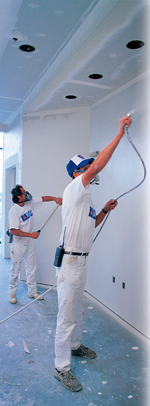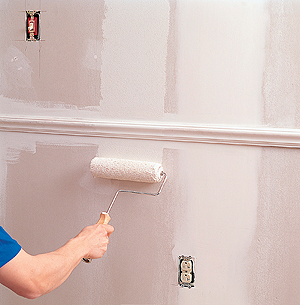
Paint Primers, Interior Primers
All good interior primers perform the basic functions of sealing, hiding and bonding to form a firm foundation for topcoats.
by Steve Revnew, Sherwin-Williams Company, Cleveland, Ohio
to any job’s success. But before you pick up that brush or roller and jump in, consider the numerous factors involved in achieving an attractive, durable finish.
Questionable substrates, new materials, workmanship, time constraints, scheduling conflicts and tight budgets combine to make a quality, profitable finish more difficult than ever to achieve. That’s why primers — as mundane and ordinary as they may seem — are key to the final outcome of any paint job. Primers solve problems. Chances are you won’t be satisfied with the topcoat if you don’t use the right primer. In many cases, you’re likely facing myriad surface problems that prevent you from achieving the finish your customer demands and expects. If substrates were perfect, there would be no need for a primer, but such surfaces are few and far between. Using the right primer also can influence job efficiency. Primers reduce surface preparation expense, improve paint coverage, speed topcoating and reduce callbacks — all which can lead to significant savings in time and money.
All good primers perform the basic functions of sealing, hiding and bonding to form a firm foundation for topcoats. Modern research and development has allowed for the emergence of new primer technologies — products that not only provide the basics but attack specific problems. If you have a tough stain to cover, rough tape joints or even a porous surface, chances are there’s a primer solution that will help you achieve the finish you and your customer expect.
Choosing the right primer isn’t as difficult as it appears. You know the job’s scope and limitations—use this knowledge to make the proper primer decision.
Think of the vast range of problems you face in trying to deliver the expected finish coat, appearance and performance:
- Sealing problems
- Adhesion problems
- Enamel sheen uniformity
- Topcoat hiding
- Uniformity of rough, irregular surfaces
- Curing time between coats
Next consider the substrate’s condition and the topcoat finish you’d like to achieve and compare these factors to the primer categories.
Sealing primers seal, lock-out and hide stains, graffiti, tannin bleed and damage from other trades. Some primers in this category seal out moisture and efflorescent salts, or block odors. These primers are ideal for delivering the best appearance of flats and enamels on walls, doors, trim, exterior siding and fresh masonry.
Primers in this category generally are 100 percent acrylic. Most effectively seal out common stains found in architectural settings. Perfect for rehab work, this category tends to ensure a smooth uniform topcoat without stains bleeding through. Bonding primers tightly anchor topcoats to slick and hard-to-paint surfaces, promoting durable adhesion and reducing prep time. Use these latex primers under flat and enamel coatings on such substrates as PVC pipe, laminates, galvanized metal, hardboard, plastic trim and molding, and greenboard, varnished or enameled surfaces. Another category of primers maximize gloss and leveling of the topcoat. They also provide excellent holdout on multiple substrates of varying porosity to ensure uniformity and excellent image, otherwise known as gloss. Use this category as a primer or undercoater under enamels or flats on walls, doors, drywall, plaster, and wood to eliminate dull spots, “strike in” or “shiners.”  The 100 percent acrylic-latex versions of these primers tend to be fast drying and ideal for all-around, general use, while allowing them to be sanded — if desired — two hours after application. The 100 percent acrylic-latex versions of these primers tend to be fast drying and ideal for all-around, general use, while allowing them to be sanded — if desired — two hours after application.
For those tradition-bound users, oil-based undercoaters in this category are an alternative when ensuring that enamel topcoats develop their full gloss on interior wood. Such primers penetrate the paintable surface, sealing and protecting it to promote paint adhesion. Topcoat gloss is maximized with uniform color and shine, eliminating the need for extra topcoats. Use on new or repaint projects; interior woodwork and trim; crown molding, doors, furniture and greenboard; and on walls under wallcovering. Hiding primers ensure uniform color and appearance, as well as hiding the substrate, previous color and surface marks. These primers, when used under flat and enamel coatings on walls and ceilings, minimize topcoat touchups and increase the effectiveness of topcoats, therefore reducing application costs. These general-purpose wall primers improve appearance and performance. They can seal drywall and hide stains. Also effective as a barrier coat for dramatic color changes, this category also can work well as a sealer under and/or over sprayed-on textured surfaces. Use on new and previously painted interior walls, drywall, plaster, masonry and concrete walls. Surfacing primers smooth the substrate and permit uniform topcoat sheen. These products achieve this by filling, leveling and sealing porous, rough, uneven and dissimilar surfaces. Such primers are ideal for use under flats and enamels on new drywall construction, heavy renovation or restoration work and on concrete block. High-build latex surfacers mask drywall imperfections like drywall paper fuzz, scuffs, nicks, pinholes and sanding grooves, saving expensive repair and patching time on rough seams and damaged drywall prior to painting. High-build surfacers are designed to provide a smooth, even surface for the latex topcoat so that the topcoat, too, is smooth and uniform. A second type in this category — block fillers — fill, seal and ensure the uniformity of rough, porous unpainted and textured concrete and cement surfaces. These thick formulations bridge pinholes commonly found in concrete surfaces for a smooth, uniform finish coat with maximum adhesion, appearance and long-term performance. Use for the interior or exterior painting of flat-surfaced, above-grade concrete blocks, concrete, cement and masonry. Today’s primers have come a long way — both in variety and performance. Look at this categorization and these new primers as solutions to common problems. Using the right primer for the job delivers a topcoat with the ultimate in appearance, value, efficiency and profitability, now and into the future. 
|

